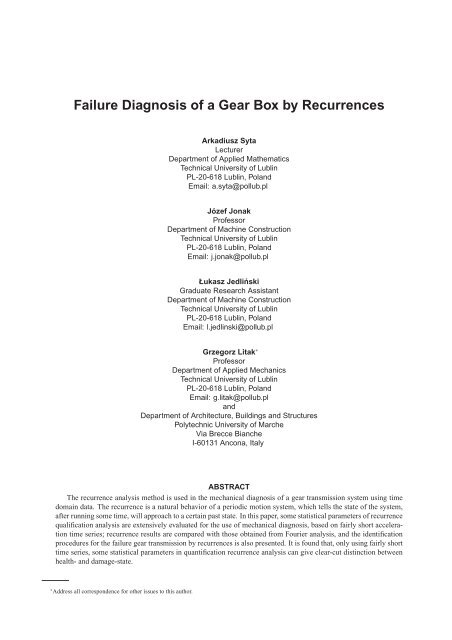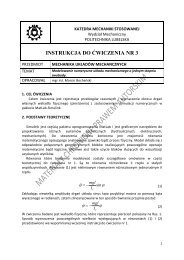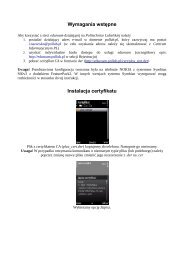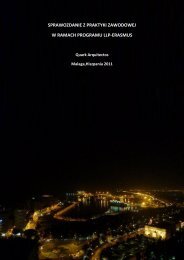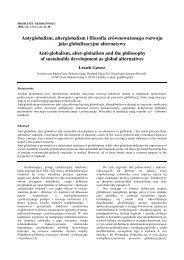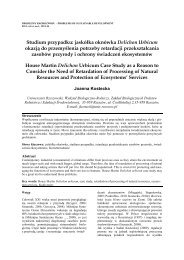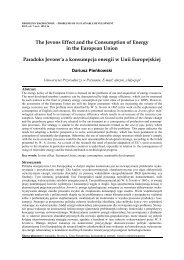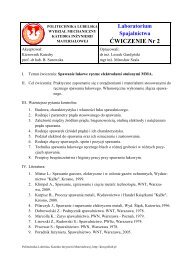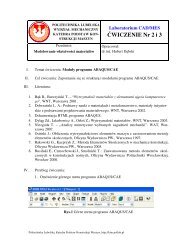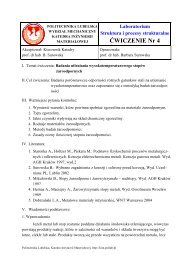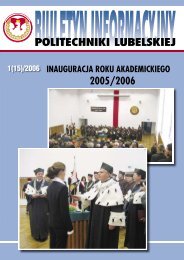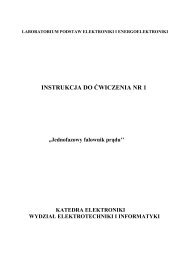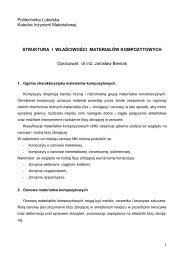pdf-preprint - Grzegorz Litak
pdf-preprint - Grzegorz Litak
pdf-preprint - Grzegorz Litak
Create successful ePaper yourself
Turn your PDF publications into a flip-book with our unique Google optimized e-Paper software.
Failure Diagnosis of a Gear Box by RecurrencesArkadiusz SytaLecturerDepartment of Applied MathematicsTechnical University of LublinPL-20-618 Lublin, PolandEmail: a.syta@pollub.plJózef JonakProfessorDepartment of Machine ConstructionTechnical University of LublinPL-20-618 Lublin, PolandEmail: j.jonak@pollub.plŁukasz JedlińskiGraduate Research AssistantDepartment of Machine ConstructionTechnical University of LublinPL-20-618 Lublin, PolandEmail: l.jedlinski@pollub.pl<strong>Grzegorz</strong> <strong>Litak</strong> ∗ProfessorDepartment of Applied MechanicsTechnical University of LublinPL-20-618 Lublin, PolandEmail: g.litak@pollub.plandDepartment of Architecture, Buildings and StructuresPolytechnic University of MarcheVia Brecce BiancheI-60131 Ancona, ItalyABSTRACTThe recurrence analysis method is used in the mechanical diagnosis of a gear transmission system using timedomain data. The recurrence is a natural behavior of a periodic motion system, which tells the state of the system,after running some time, will approach to a certain past state. In this paper, some statistical parameters of recurrencequalification analysis are extensively evaluated for the use of mechanical diagnosis, based on fairly short accelerationtime series; recurrence results are compared with those obtained from Fourier analysis, and the identificationprocedures for the failure gear transmission by recurrences is also presented. It is found that, only using fairly shorttime series, some statistical parameters in quantification recurrence analysis can give clear-cut distinction betweenhealth- and damage-state.∗ Address all correspondence for other issues to this author.
Nomenclaturex i ,x j Vector representation of the system states in discrete time i, j.ε Threshold value.RR, LAM, DET , L, T TV ENT R, LENT R Parameters defined in the Recurrence Qualification Analysis.y Average value of parameter y.σ y Standard deviation of parameter y.Kurt y Kurtosis of parameter y.R i, j Recurrence matrix.P(l), P(v) Histograms of the line diagonal and vertical lengths (l and v, respectively).p(l), p(v) Normalized probability distributions of the line diagonal and vertical lengths (l and v, respectively).PS Power spectrum.Θ(x) Heaviside step function.H1,H2 Signals corresponding to healthy gears measured by sensor No. 1 and 2, respectively.D1,D2 Signals corresponding to damaged gears measured by sensor No. 1 and 2, respectively.n Number which indicate the rotation interval.1 IntroductionGear transmission systems are widely used in real life because of their reliability and possibility of long time operation[1–5]. Due to backlash and time-varying mesh stiffness they show complex nonlinear response [6] such as chaotic vibrations[7]. Additionally, transmission errors can occur due to the wear phenomena and disturb the efficient work [8–10]. Operationalsafety requires to detect those defects before admitting the transmission system for a longer operation. The goal of the presentnote is to compare dynamics of the faulty transmission to the healthy one using nonlinear time series method of recurrenceplots. For testing purposes, we used a single-stage transmission gears pair with angular teeth mounted on an industrial teststand [11]. This kind of gears is widely used in aircraft industry, e.g. to transmit power into the tail rotor in helicopters.In the present paper, instead of using a standard frequency analysis [12], we calculate recurrence indicators from fairlyshort experimental time series of acceleration measured in different stages of the dynamical experiment. Finally, recurrenceindicators are used to assess the gear usability and/or degradation. We assume that the faults occurred in the system introducestrongly nonlinear phenomena like friction and/or backlash that can influence the stability of the whole system. To searchand identify such disturbing effects in the system dynamical response, we used a recurrence quantification analysis (RQA)which gives reliable indicators for system technical conditions [13–15].2 Recurrence quantification analysisRecurrence is a natural behaviour of the periodic motion when after some time the actual state of the system is close to acertain past state. Let x i denote a state of a dynamical system at discrete time. Similarly, let x j denote a different state of theexamined system. Consequently, a recurrence phenomenon implies those states to be close to each other (after some time),what can be written as:|x i − x j | ≤ ε, for i ≠ j. (1)This fact can be described in logical values (0 or 1) using the recurrence matrix:R i, j (ε) = Θ(ε − ||x i − x j ||), for i, j = 1,..,n, (2)where ||.|| is the Euclidean measure, and Θ(x) is the Heaviside step function.The results of the recurrence function (Eq. 2) that acts on the trajectory of the length n can be represented as a n × nmatrix made of zeros and ones where rows and columns are marked as a discrete time. Its graphical representation of thatmatrix (coloured points (i, j) for R i, j (ε) = 1, and empty places (i, j) for R i, j (ε) = 0) is called a Recurrence Plot (RP) [16,17].Note that every recurrence plot includes a single point. More recurrences can be reflected into RP as vertical, horizontallines or singular points. The points in RP can also form some other patterns possessing elements of vertical, horizontal lines.Thus, one can distinguish different kinds of motion just from recurrence plot topology.However, a more specific investigation based on the statistics of points and lines forming the plot can be made (RQA- Recurrence Quantification Analysis) [17–20]. The RQA includes a few measures based on horizontal and vertical linepatterns in terms of the statistical properties of line lengths and their distributions. Note, the diagonal lines represent the
periodic motion, while the isolated point reports a single recurrence that could appear by incidental passing through the samestate in the phase space.Recurrence rate RR:RR = 1 n 2is the ratio of the recurrence points to all possible points.Determinism DET :n∑ R i, j (ε), (3)i, j=1DET = ∑n l=l minlP(l)∑ n l=1 lP(l) (4)shows the contribution of points forming diagonal lines. P(l) is a histogram of diagonal lines of length l.Laminarity LAM:LAM = ∑n v=v minvP(v)∑ n v=1 vP(v) (5)shows the contribution of points forming vertical lines. P(v) is a histogram of vertical lines of length v. DET and LAM showhow many recurrence points are included in various diagonal and vertical lines. The first one (DET) used to characterizehow periodic is the system dynamical response while the second (LAM) identifies small (laminar) changes in recurrencesby calculating the ratio of small deviations in the recurrences to all recurence points. Interestingly, small deviations inrecurrences are represented by vertical lines in RP.The average length of diagonal lines L:L = ∑n l=l minlP(l)∑ n l=l minP(l)(6)can reflect the time correlation of time series, which is related to the average time of a periodic motion.The average length of vertical lines called trapping time T T :T T = ∑n v=v minvP(v)∑ n v=v minP(v)(7)is a similar indicator to L but defined for vertical lines, which can tell about the characteristic time of a laminar motion. TheShannon entropy for diagonal lines L entr :where p(l) is probability of finding a diagonal line of length l.The Shannon entropy for vertical lines V entr :n∑LENT R = − p(l)ln p(l), (8)l=l minn∑V ENT R = − p(v)ln p(v), (9)v=v minwhere p(v) is probability of finding a vertical line of length v. Note, the parameters LENT R and V ENT are particularlysensitive to noise.The maximum length of diagonal and vertical lines is LMAX and V MAX, respectively.These quantities, or more precisely changes of their values in the system conditions, illustrate the dynamics of theunderlying system. E.g. DET in a periodic system (long diagonal lines and few single points) takes a higher value than in astochastic system (only single points). Note that the correct results of the RQA depend on proper choice of the embeddingparameters (embedding dimension and embedding time delay). Furthermore, a subspace of all measured coordinates can beused.
3 The experimental set-up and resultsWe have tested single-stage transmission gears with angular teeth. The scheme of the gears and the location of theacceleration sensors are shown in Fig. 1.The gears were dismounted and examined carefully after being in operation for a long time. It appeared that the gearsystem had been damaged, therefore the transmission system was replaced by a new (healthy) one and run again. We haverecorded the vibration of acceleration in three directions (x,y,z) with a sampling frequency of 40 kHz for both damaged andhealthy systems.The damage of the transmission occurred after 3 hours and 15 minutes of the gear system work. The stop signal was dueto the presence of a chips sensor. There has been a blurring effect due to the incorrect assembly of gears. The accelerationdata was recorded regularly since the beginning of transmission to the occurrence of the damage.More detailed analysis of the dismounted gears provided evidence that the lateral surface of the teeth had been damaged.The transmission system was replaced by the new (healthy) one and run again. The pinion had 19 teeth and was rotating withspeed of 6196 rpm, and the driven wheel had 42 teeth. The data consists of 160 revolutions of the pinion, which correspondto 61960 points of the system evolution and a run time of 1.549 seconds. For the purpose of our analysis we divided thewhole period into 10 rotation intervals, each of 16 revolutions.In this project we compare the system response records obtained from two piezoelectric triaxial sensors. To obtain moreinformation, than from the Fourier analysis, we apply the method of recurrence plots. Initial results related to this gearsystem have been recently reported by Jedliński at al. [11] who used frequency domain analysis. He filtered the measuredsignal to find differences between the healthy and faulty transmission gears. In the present approach, instead of using afiltering algorithm, we propose to use the simultaneously recorded data from 3 directions. The obtained data form vectors ofthe phase space.Thus, we focus on comparison of the two different time series for faulty and healthy gears, recorded with a single 3dsensor ( No. 1 in Fig. 1). As expected, the sensor No. 2 (Fig. 1) gave similar results (see Tab. 1). The correspondingtime series for the healthy and damaged gears are presented in Fig. 2. Note that the wider distribution of measured pointsis clearly visible for the faulty gear pair (Fig. 2b). In Tab. 1 one can compare Basic statistical parameters including meanvalues, standard deviation and kurtosis used for all 3 directions, i.e. x, y, and z are compared in Tab. 1.Comparing the statistics obtained, higher mean values for acceleration of healthy gears in y and z direction (H1) canbe noted. On the other hand, the standard deviation of acceleration in the same direction is higher for the signal D1 of thedamaged gears. The time series obtained from the second sensor behave in a similar way (almost all statistic parameterstake higher values for signal D2). Interestingly, kurtosis is clearly larger for the damaged systems (Kurt 3, i = x,y,z) ascompared to the healthy ones (Kurt i 3 where i = x,y,z). All estimated kurtosis values are relatively close to that of theGaussian distribution (Kurt = 3). However, their small systematic variation indicates a platykurtic distribution of measuredpoints ( flatter than the Gaussian) for the damaged system, while the healthy system shows a leptokurtic density (more peakydistribution). Note that the Gaussian process can be associated with the presence of random external force and/or torquedisturbances. The change in kurtosis indicates the additional correlated effect of internal forces in the gear system. The largeincrease can detect intermittency [21].To make further progress with the recurrence analysis the corresponding time series have been normalized properly totheir standard deviations.4 The RQA results and discussionThis section reports the results of RQA for time series describing magnitudes of gears system acceleration with damagedand healthy transmission gears. In the search for differences between the considered systems we performed the RQA analysisfor 10 consecutive rotation intervals. For each period, recurrence quantifiers defined in the previous section with the assumedcritical distance (threshold value) ε = 0.5 and minimal length of a diagonal and vertical line equal to 2 were calculated.Instead of the embedding space estimation [22, 23] we used a 3 dimensional space spanned on the 3 axial accelerationsignals (x,y,z).Using the experimental data, RQA measures were calculated to distinguish between healthy and damaged gears (Figs.3-13). RR values for different revolutions and two sensors are compared in Fig. 3.As depicted in Fig. 3, RR takes similar values. Careful inspection shows that a slightly wider range of RR (RR ∈[0.0094,0.0170]) and simultaneously the mean value are related to the healthy gears (see RR ∈ [0.0104,0.0126] for thedamaged gears). Consequently, our main conclusion based on Fig. 3 is that the recurrences occur at the similar level, buttheir distribution can be different.The examples of the recurrence plots for one chosen rotation interval (No. 8) are given in Fig. 4. Note that, RR is thesame here (see Fig. 3a) for sensor No. 1 and fairly similar for sensor No. 2 (see Fig. 3b). The vertical scales are differentin Fig. 3a and b. This coincidence (Fig. 3a) makes plausible the comparison of the statistics of the diagonal and verticallines for both gear systems, i.e. healthy and damaged. Namely, the same RR implies the same number of recurrence points
for different dynamical responses reflected in different patterns in Fig. 4. The RR matrix for the damaged gear signal looksmore reddish because of the resolution (with the same number of recurrence points).Interestingly, the transition from a healthy to a damaged system is associated with different vertical line structures.The apparent evolution from a more like checkerboard and larger square patterns (Fig. 4b) into a collection of vertical andhorizontal short lines (Fig. 4a) resembles the intermittency transition discussed by Klimaszewska and Żebrowski [24]. Thelarger difference of T T in the two examined cases (healthy and damaged) should also reflect the effect.Fig. 5 shows the selected RQA parameters (RR, DET , LAM, LENT R, V ENT R, and T T ) versus the threshold value εfor case No. 8 of the same healthy and damaged gear signals obtained from sensor No. 1 (see Fig. 3a). There are visiblecorresponding lines splitting in the region of small ε for DET , LAM, and V ENT R. Simultaneously, RR lines are very close(Fig. 5a). T T lines (Fig. 5f) are also split but for fairly larger ε, while LENT R lines (Fig. 5d) are fairly close in the wholeregion, making a noticeable difference in order of altitudes LENT R(healty) > LENT R(damaged) → LENT R(damaged)
Based on power spectra for y and z direction one can see peaks with higher amplitude and frequency for damaged gearcan be noted. The corresponding values of peaks are much higher than the shaft speed (103 Hz).That indicates harmonics at high frequency in the damaged but not healthy gear system. Obviously, one can see there isa frequency shift for higher frequencies of the damaged system response appearing in all directions (Figs 14a–c). Simultaneously,power spectra for the gear vibrations are within a narrower range in the presence of defects. This effect is the mosttransparent in z direction (Fig. 14c). The shift of the peaks and the corresponding frequency band shrinking are the effectswhich accompany defects. In the recurrence approach we can notice the ordering of oscillations which slightly change frominterval to interval.5 Summary and conclusionsIn summary, we have applied the nonlinear recurrence based method analysis to experimental data taken from theaviation power transmission. Analysis of experimental data is difficult, mainly due to influence of additional noise thatcan distort the results [26]. To distinguish a healthy gear transmission from a damaged one, the recurrence indicators areused. Applying the RQA allows for detecting systematic differences in the values of DET and LAM, assumed as quantifiers.Interestingly, the effect is also noted in Kurtosis (Tab. 1). We have also noticed that results may slightly vary with changesof the parameters values (L, LMAX, LENT R, T T , V MAX, V ENT R) due to a sensor selected. Such a choice implies moreimplies more careful fixing the value of ε in order to minimize the variations of RR. The averaging procedure applied to theRQA parameters over 10 rotation intervals has helped to cancel their fluctuations (Tab. 2).Additionally, the examined data indicate stationary vibrations as there are no jumps in recurrences ratios or statisticalindicators.To conclude, the new method of monitoring a gear system is recommended for an industrial environment. The advantageof the recurrence approach is that only two parameters RR and DET identifying a defect instead of observing the wholefrequency spectrum of the Fourier analysis in each interval. However, more systematic experiments with different thresholdvalues ε, as well as various kinds of gear defects should be done before the implementation of this method to the industry.AcknowledgementThe research leading to these results has received partial funding from the European Union Seventh Framework Programme(FP7/2007-2013), FP7 - REGPOT - 2009 - 1, under grant agreement No: 245479.References[1] Harris, S.L. 1958. Dynamic loads on the teeth of spur gears. Proc. Inst. Mech. Eng. 172, 87–112.[2] Parker, R.G., Vijayakar, S.M., Imajo, T. 2000. Nonlinear dynamical response of a spur gear pair: modelling andexperimental comparisons. J. Sound Vib. 237, 435–455.[3] Warmiński, J., <strong>Litak</strong>, G., Szabelski, K. 2000. Dynamic phenomena in gear boxes. In: Applied Nonlinear Dynamicsand Chaos of Mechanical Systems with Discontinuities (Wiercigroch, M. & De Kraker, B. editors), Series on nonlinearscience A, vol. 28, (World Scientific, Singapore) pp. 177-205.[4] Guo, Y., Parker, R.G. 2010, Sensitivity of general compound planetary gear natural frequencies and vibration modes tomodel parameters. J. Vib. Acoust. 132, 011006.[5] Cooley, C.G., Parker, R.G., Vijayakar S.V. 2011. A frequency domain finite element approach for three-dimensionalgear dynamics. J. Vib. Acoust. 133, 041004.[6] Kahraman, A., Singh, R. 1991. Interactions between time-varying mesh stiffness and clearance nonlinearity in a gearsystem. J. Sound Vibr. 146, 135–156.[7] Byrtus, M., Zeman, V. 2011. On modeling and vibration of gear drives influenced by nonlinear couplings. Mechanismand Machine Theory 46, 375–397.[8] Łazarz, B., Wojnar, G. Madej, H., Czech, P. 2009. Evaluation of gear power losses from experimental test data andanalytical methods. Mechanika 6, 56–63.[9] Lin, J., Parker, R.G. 2002. Parametric instability of planetary gears under mesh stiffness variation. J. Sound Vibr. 29,411–429.[10] <strong>Litak</strong>, G., Friswell, M.I. 2005. Dynamics of a gear system with faults in meshing stiffness. Nonlinear Dynamics 41,415–421.[11] Jedliński, Ł., Kisiel, J., Jonak, J. 2009. Diagnosing the condition of gear transmission on the basis of periodic andresidual components of the signal spectrum. Diagnostyka 49, 51–67.[12] Lyons R. G. Understanding Digital Signal Processing, Prentice Hall, New Jersey 2004.[13] <strong>Litak</strong>, G., Sawicki, J.T., Kasperek, R. 2009. Cracked rotor detection by recurrence plots. Nondestructive Testing andEvaluation 24, 347–351.
[14] <strong>Litak</strong>, G., Syta, A., Gajewski, J., Jonak, J. 2010. Detecting and identifying nonstationary courses in the ripping headpower consumption by recurrence plots. Meccanica 45, 603–608.[15] Nichols, J.M., Trickey, S.T., Seaver, M. 2006. Damage detection using multivariate recurrence quantification analysis.Mech. Syst. Signal Process. 20, 421–437.[16] Eckmann, J.-P., S.O. Kamphorst, S.O., Ruelle, D. 1987. Recurrence plots of dynamical systems. Europhys. Lett. 5,973–977.[17] Webber Jr. C.L., Zbilut, J.P. 1994. Dynamical assessment of physiological systems and states using recurrence plotstrategies. J. App. Physiol. 76, 965–973.[18] Marwan, N. 2003. ‘Encounters with Neighbours: Current Development of Concepts Based on Recurrence Plots andtheir Applications. PhD Thesis, Universität Potsdam, Potsdam.[19] Marwan, N., Romano, M.C., Thiel, M., Kurths, J. 2007. Recurrence plots for the analysis of complex systems. PhysicsReports 438, 237–329.[20] Marwan, N., Commandline recurrence plots, http:// www.agnld.uni- potsdam.de/ ∼marwan/ 6.download/ rp.php (May10th 2009).[21] Sen, A.K., <strong>Litak</strong>, G., Edwards, K.D., Finney, C.E.A., Daw, C.S., Wagner R.M. 2011. Cyclic heat release variabilitywith transition from spark ignition to HCCI in internal combustion engines, Applied Energy 88, 1557–1567.[22] Takens, F. 1981. Detecting Strange Attractors in Turbulence, Lecture Notes in Mathematics, Vol. 898 (Springer, Heidelberg)pp. 366–381.[23] Kantz, H., Schreiber, T. 1997. Non-linear Time Series Analysis, (Cambridge University Press, Cambridge).[24] Klimaszewska, K., Żebrowski, J.J. 2009. Detection of the type of intermittency using characteristic patterns in recurrenceplots. Phys. Rev. E 80, 026214.[25] <strong>Litak</strong>, G., Wiercigroch, M., Horton, B.W, Xu, X. 2010. Transient chaotic behaviour versus periodic motion of a parametricpendulum by recurrence plots. Z. Angew. Math. Mech. 90, 33–41.[26] Mo, E., Naess, A. 2009. Nonsmooth dynamics by path integration: an example of stochastic and chaotic response of ameshing gear pair. J. Comput. Nonlinear Dynam. 4, 034501.
Table 1. Statistic properties of time series. The signal D1 stands for acceleration of the faulty gear recorded by the first sensor, H1 -acceleration of the healthy gear; the signals D2 and H2 - obtained from the second sensor.Signal ¯x ȳ ¯z σ x σ y σ z Kurt x Kurt y Kurt z[m/s 2 ] [m/s 2 ] [m/s 2 ] [m/s 2 ] [m/s 2 ] [m/s 2 ]D1 0.119 0.458 0.547 108.25 107.30 99.82 2.929 2.575 2.879H1 0.111 0.139 0.198 113.54 201.88 210.91 3.109 3.061 3.164D2 0.557 0.153 0.157 138.17 127.17 108.36 3.032 2.954 2.913H2 0.217 0.192 0.464 197.66 161.55 214.48 3.214 3.195 3.162
Table 2. Average values of RQA for all presented revolutions Nos. 1-10 with ε = 0.5. The signal D1 stands for acceleration of the faultygear recorded by the first sensor, H1 - acceleration of the healthy gear; the signals D2 and H2 - obtained from the second sensor.Signal RR DET LMAX L LENT R LAM V MAX T T V ENT RD1 0.029 0.345 22.4 2.4 0.853 0.528 10.9 2.4 0.859H1 0.032 0.571 44.9 2.6 1.076 0.742 17.0 2.8 1.280D2 0.033 0.371 28.0 2.5 0.958 0.553 13.9 2.5 0.984H2 0.035 0.482 39.4 2.5 0.929 0.675 16.7 2.6 1.133
(a)(b)Fig. 1. (a) Location of the sensors on the shaft where 1 and 2 stand for first and second sensor, respectively [11]. (b) 3D schematic view ofa gear system.
x acceleration [m/s^2]4002000-200-400(a)0 0.2 0.4 0.6 0.8 1 1.2 1.4t [s]x acceleration [m/s^2]4002000-200-400(b)0 0.2 0.4 0.6 0.8 1 1.2 1.4t [s]Fig. 2.Acceleration time series describing acceleration in x direction of system with a pair of damaged (1D - (a)) and healthy (1H - (b))gears, obtained by the sensor No. 1
0.018RR0.0160.0140.0120.01H1D1(a) 1 2 3 4 5 6 7 8 9 10Revolutions x 160.0160.015H2RR0.0140.0130.012D2(b) 1 2 3 4 5 6 7 8 9 10Revolutions x 16Fig. 3. (color online) Recurrence rate RR for healthy; H1 (a), H2 (b) (green dashed lines) and damaged; D1 (a), D2 (b) (red full lines) gearscalculated with ε = 0.5.
Fig. 4.Recurrence plots (with ε = 0.5) for the rotation interval No. 8 for the signals obtained from the sensor No. 1 (see Fig. 3a), anddifferent gear systems: healthy (a) and damaged (b) ones, respectively. The embedding space consist of x, y, and z acceleration components.
RR(a)LAM(c)10.90.80.70.60.50.4damaged healthy0.30.20.100 0.5 1 1.5 2 2.5 3 3.5 4 4.5 5ε10.9 healthy0.80.70.60.50.4damaged0.30.20.100 0.5 1 1.5 2 2.5 3 3.5 4 4.5 5ε6DET(b)LENTR(d)10.9 healthy0.80.70.60.50.4damaged0.30.20.100 0.5 1 1.5 2 2.5 3 3.5 4 4.5 5ε876543healthydamaged2100 0.5 1 1.5 2 2.5ε3 3.5 4 4.5 5100580VENTR432healthydamagedTT6040healthydamaged120(e)00 0.5 1 1.5 2 2.5 3 3.5 4 4.5 5ε(f)00 0.5 1 1.5 2 2.5 3 3.5 4 4.5 5εFig. 5. (color online) Selected RQA parameters versus ε for the case No. 8 of the signals obtained from the sensor No. 1 (see Fig. 3a), anddifferent gear systems: healthy (green dashed lines) and damaged (red full lines), respectively. The embedding space consists of x, y, and zacceleration components.
DETDET0.450.40.35H10.30.250.2 D10.15(a) 1 2 3 4 5 6 7 8 9 10Revolutions x 160.320.30.28H20.260.240.22 D20.2(b) 1 2 3 4 5 6 7Revolutions x 168 9 10Fig. 6. (color online) Determinism DET for healthy; H1 (a), H2 (b) (green dashed lines) and damaged; D1 (a), D2 (b) (red full lines) gearscalculated with ε = 0.5.
LMAX3020H110D1(a)1 2 3 4 5 6 7 8 9 10Revolutions x 16LMAX2218H214D1(b) 1 2 3 4 5 6 7 8 9 10Revolutions x 16Fig. 7. (color online) LMAX for healthy; H1 (a), H2 (b) (green dashed lines) and damaged; D1 (a), D2 (b) (red full lines) gears calculatedwith ε = 0.5.
2.42L2.382.34H12.32.26D1(a) 1 2 3 4 5 6 7 8 9 10Revolutions x 162.342.32H2L2.3D22.28(b) 1 2 3 4 5 6 7 8 9 10Revolutions x 16Fig. 8. (color online) L for healthy; H1 (a), H2 (b) (green dashed lines) and damaged; D1 (a), D2 (b) (red full lines) gears calculated withε = 0.5.
LENTR0.850.750.65H1D1(a) 1 2 3 4 5 6 7 8 9 10Revolutions x 160.75LENTR0.730.710.690.67H2D2(b) 1 2 3 4 5 6 7 8 9 10Revolutions x 16Fig. 9. (color online) LENT R for healthy; H1 (a), H2 (b) (green dashed lines) and damaged; D1 (a), D2 (b) (red full lines) gears calculatedwith ε = 0.5.
0.60.5H1LAM0.40.3D1(a) 1 2 3 4 5 6 7 8 9 10Revolutions x 160.5LAM0.460.420.380.34H2H1(b) 1 2 3 4 5 6 7 8 9 10Revolutions x 16Fig. 10. (color online) Laminarity LAM for healthy; H1 (a), H2 (b) (green dashed lines) and damaged; D1 (a), D2 (b) (red full lines) gearscalculated with ε = 0.5.
VMAX15131197H1D1(a) 1 2 3 4 5 6 7 8 9 10Revolutions x 1615H213VMAX1197D2(b) 1 2 3 4 5 6 7 8 9 10Revolutions x 16Fig. 11. (color online) V MAX for healthy; H1 (a), H2 (b) (green dashed lines) and damaged; D1 (a), D2 (b) (red full lines) gears calculatedwith ε = 0.5.
2.55TT2.452.352.25H1D1(a) 1 2 3 4 5 6 7Revolutions x 168 9 102.44TT2.42.362.322.28H2D2(b) 1 2 3 4 5 6 7 8 9 10Revolutions x 16Fig. 12. (color online) Trapping time T T for healthy; H1 (a), H2 (b) (green dashed lines) and damaged; D1 (a), D2 (b) (red full lines) gearscalculated with ε = 0.5.
VENTR1.0510.90.80.70.6H1D1(a) 1 2 3 4 5 6 7 8 9 10Revolutions x 160.9H2VENTR0.80.7D1(b) 1 2 3 4 5 6 7 8 9 10Revolutions x 16Fig. 13. (color online) V ENT R for healthy; H1 (a), H2 (b) (green dashed lines) and damaged; D1 (a), D2 (b) (red full lines) gears calculatedwith ε = 0.5.
0.080.06PS0.04H10.02D10(a)0 1000 2000 3000 4000 5000 6000 7000 8000Frequency [Hz]D10.2PS0.1H100 1000 2000 3000 4000 5000 6000 7000 8000(b)Frequency [Hz]0.08D10.06PS0.04D10.02H1H100 1000 2000 3000 4000 5000 6000 7000 8000(c)Frequency [Hz]Fig. 14.(color online) Power spectra for the revolution No. 8 estimated for x acceleration (a), y acceleration (b), z acceleration (c) for thehealthy (green) and damaged (red) transmission gears. Note that the damaged system spectra have more localized and larger frequencies.


